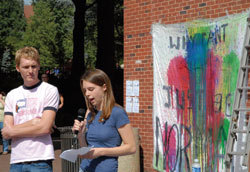Features
Between 18 credits, multiple clubs and Congressional internships, most Georgetown students believe they are making the most of life, even at the expense of sleep. Yet it all pales in comparison to a few fellow students for whom extracurricular activities mean something else entirely: Georgetown students with kids of their own.
Mention Georgetown students with kids and the common response is, “Are there any?” Georgetown is not a community where one might expect people to have children, start a family, or settle down. Jennifer Kueler (SFS ‘09), President of GU Right to Life and liaison to the University’s Health Education Services, is not surprised.
“Personally, the sense that I get is that Georgetown is so intense, anything that impedes someone from getting the degree, the internship, etc., becomes very hush-hush,” she said. “Pregnant students don’t fit in the sense that they think that having a family is more important than having a career.”
By
Shira Hecht
October 11, 2007


